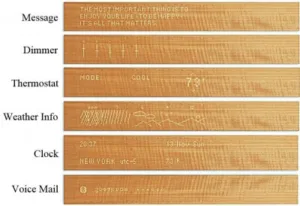The principle offices of the Nissha Company are in Kyoto, Japan. A new branch of the company has just been formed and it called mui Lab, Inc. Mui Labs has developed an odd and oddly appealing display product called mui.
To some extent, the reason behind the choice of the traditional Japanese word “mui” for the name of both the company and the company’s first product is to feature the product philosophy the company wishes to project. The definition of mui is “silence.” The company web site explains that mui depicts a natural sense of mind, inactivity, idleness. Additional meanings the company wishes to associate with the product include effortless comfort, out of sight until needed and out of mind until used.
Seems very “new age” but what, exactly, is the mui product? Well, it is “a new interface product for the Internet of Things market,” a “revolutionary aesthetic approach to user interface design.” More specifically, when the device is not in use, it looks like an attractive but nondescript block of wood. When in use, the device connects to the Internet and can switch between the functions of an input device and a display.
The mui includes a built-in touch sensor and a wireless connection that can be used to control Internet of Things (IoT) functions such as room lighting and temperature. It can also work as a display to show information such as messages, time, weather and temperature. In sum, “It is possible to link the various cloud-based services and display the obtained information on the display in real time.”
The video at the end of this article discusses and illustrates the mui device. The figure below pictures the mui interactive device displaying several different types of information.
The mui display presenting several different types of information.
The appearance of the mui product will eventually be available in forms other than wood including mirror glass, red fabric and marble.
Technical specifications of the mui include the following.
Currently, the mui is in the prototype stage as is its’ companion app. Integration with Alexa and IFTTT (IF This Then That, a free, web-based service to create simple applets) are also still in the development phase. At this time, the device uses myThings (an IoT service by Yahoo Japan).
Also at this time, the mui is compatible with IoT enabled Net LED and Philips Hue light bulbs but is anticipated to work with additional smart lights in the future.
Current on-line speculation is that additional funding needed to launch the mui will be raised using a crowd funding campaign scheduled for about June, 2018. The price of the mui is anticipated as falling somewhere between a very hefty $900 and $1,200. -Arthur Berman
Nissha Company (Kyoto, Japan), Fumiaki Shibayama, +81-75-823-5374, [email protected]

